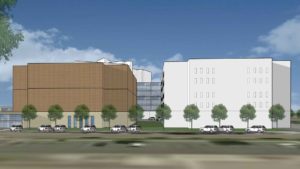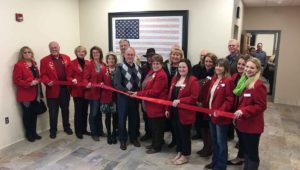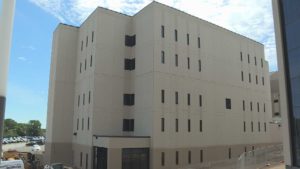The county found its facility planner with the help of Aunt Google, and, of all the projects the county has done, Williams County Chairman David Montgomery thinks it’s the best in his 14 years of service.
“From county highway to the original jail, to the building of the Broadway Commons, and building out the youth assessment center … this one has actually been the best we have had as far as accommodating everyone and the efficiency, with no cost over-runs,” he said. “And to have it come in under budget. – that’s huge.”
Steinmann had originally estimated the project would cost $$54 million, but needed just 1 percent of the 10 percent contingency fund that he’d set aside. The project thus was completed for $50 million.
Williams County Commissioners and county employees gathered with community members Monday afternoon to celebrate the completion of their new three-building campus in downtown Williston, with 126,536 square feet of new shining through all around the guests.
Of the total square footage that was either remodeled or added to, 80,181 square feet were brand new, while the remaining 46,355 existed, but were remodeled to match new spaces. In fact, it was impossible to tell Monday, which were old and which were new as the community gathered to enjoy coffee and cookies, as well as stories about the new complex.
One of the things Montgomery particularly likes about the county’s facilities project, besides the fact that it was under budget, is that it will not only serve the present need, but he feels confident it will serve future needs as well. They won’t be likely to need a new facility in five years.
“We went out of our way to forecast what Williams County would need at the mature population of about 75,000 permanent residents in the community, which seems to be the realistic buildout of the entire community, for the county-wide area,” said facilities planner Jim Steinmann.
That number exceeds forecasts by the oil and gas industry and the state, as well as Census Bureau estimates, but Steinmann feels sure it is a realistic maximum for the area, based on the infrastructure, land area and major transportation corridors..
Steinmann estimates the current population of Williams County is around 45,000, including temporary workers who don’t necessarily live here, but are present on a regular basis to do work, and thus, from time to time, use one more more services available through the county.
The sudden influx of so many new people during the boom was taxing for county facilities that had been set up to serve a much smaller population. Trying to hire staff to meet the sudden demand created many space issues, Human Resources Director Helen Askim recalled.
Not only were county administration facilities overwhelmed. The new jail, just built five years prior, was also quickly swamped.
“We thought it was a 50-year jail, and it was full,” Askim recalled.
Williams County Sheriff Verlan Kvande started in corrections in 1998, when the county had just 32 beds for inmates. The new jail built just five years before the boom had increased that to 132, which designers at the time thought should be good for another 50 years.
“I cannot imagine what (32 beds) would have been like with the oil boom,” Kvande said. “Even with the 132 beds we had, in the course of (the boom), many times we were in the 150s to 160s.”
The recent downturn in oil prices did not alleviate space issues at the jail, Kvande added. Law enforcement continued to face challenges, particularly when it comes to space.
“We had to do something,” he said.
The new jail has 244 beds. It also now has an enclosed area for inmates to get daily fresh air, that includes acoustical baffles to control sound. Neighbors can no longer hear basketballs being dribbled, or words that they don’t want their children to hear.
Steinmann said the jail also includes a “knockout” panel, so that more beds can be added later, should the county ever exceed his 75,000 population estimate.
“You can do a mirror image expansion on that back parking lot and add another 120 beds,” he said.
The court system, like the jail, was also swamped. It was not built for the volume of cases the boom brought, recalled Judge Josh Rustad.
When he was elected in 2010, two judges were handling Williams, McKenzie and Divide counties. There were two courtrooms, only one of which could have a jury trial.
“Shortly after election, it became apparent that what was transpiring was an explosion in our caseload,” Rustad said. “And the complexity of cases were increasing. We needed more judges, we needed more courtrooms, we needed more space.”
The Williams County Courthouse, which stayed in the existing facility, now has five courtrooms. That has dramatically increased the capacity of municipal and district courts, and helped keep cases moving on a weekly basis.
“This is the culmination of a lot of hard work, vision and planning by a lot of people, to handle not just the issues of today, but the future,” Rustad said. “None of this would have been possible without the foresight of the commission.”
Montgomery, meanwhile, said the credit goes to Steinmann and all the contractors working on the project.
“We know the citizens of western North Dakota have borne a heavy price in the last eight years, and not just financial,” Montgomery said. “But we have set out to complete this project without raising any property taxes, and I’m confident that we will be able to achieve that goal.”
Steinmann is president of Steinmann Facility Development Consultants in Lake Tahoe, California. He was discovered by then-Williams County Commissioner Dan Kalil, who, having been told by one of the construction firms the county had worked with that they needed a facilities planner rather than an architect, took to the Internet to find one.
Steinmann recalled getting a call from Kalil on a Saturday out of the blue, and agreeing to come up, free of charge to take a look around. A couple days later, he pitched a plan that would solve all the county’s problems at $54 million. That surprised commissioners at the time, since previous estimates had ranged between $75 to 80 million.
More than 1,000 people worked on the facilities project, which remodeled 12,745 square feet for the law enforcement center, 16,140 square feet for the courthouse and 17,470 square feet for the Administration building.
New space included an additional 28,650 square feet for the administration building and 51,531 for the correctional and law enforcement centers.
Marc Mellmer, vice president of JE Dunn Construction, which built the facilities, thanked the county and staff for their patience during all the construction.
“We completely ripped apart almost every square inch of this structure and the one across the street,” he said. “We tore up the parking lots and we displaced everyone.”
Despite that, county offices remained open and functional throughout the construction period.
“Thanks to everyone for putting up with this the way you did,” Mellmer said. “It’s a great thing when we can take a building like this and not demolish it and make use of it and make it last for years to come. (These buildings) are going to last for years to come.”



